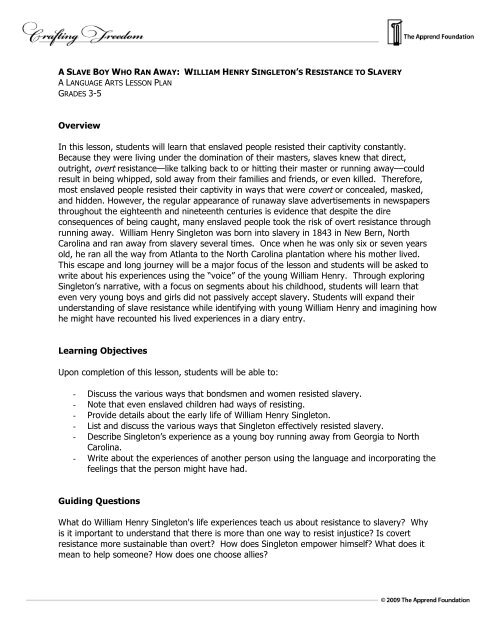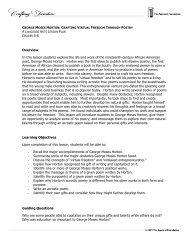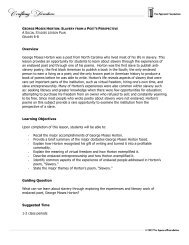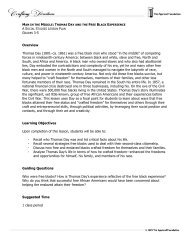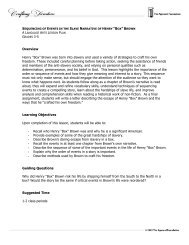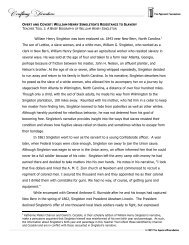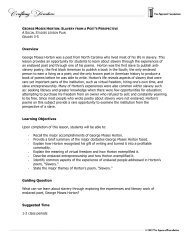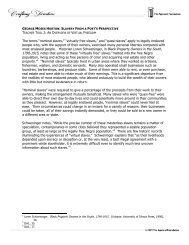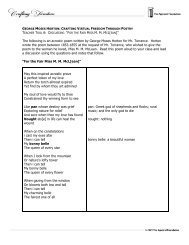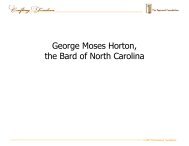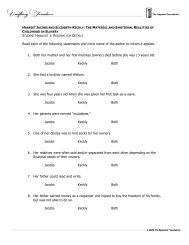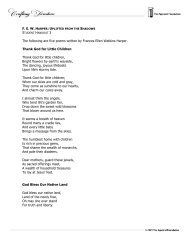Overview In this lesson, students will learn that ... - Crafting Freedom
Overview In this lesson, students will learn that ... - Crafting Freedom
Overview In this lesson, students will learn that ... - Crafting Freedom
Create successful ePaper yourself
Turn your PDF publications into a flip-book with our unique Google optimized e-Paper software.
A SLAVE BOY WHO RAN AWAY: WILLIAM HENRY SINGLETON’S RESISTANCE TO SLAVERY<br />
A LANGUAGE ARTS LESSON PLAN<br />
GRADES 3-5<br />
<strong>Overview</strong><br />
<strong>In</strong> <strong>this</strong> <strong>lesson</strong>, <strong>students</strong> <strong>will</strong> <strong>learn</strong> <strong>that</strong> enslaved people resisted their captivity constantly.<br />
Because they were living under the domination of their masters, slaves knew <strong>that</strong> direct,<br />
outright, overt resistance—like talking back to or hitting their master or running away––could<br />
result in being whipped, sold away from their families and friends, or even killed. Therefore,<br />
most enslaved people resisted their captivity in ways <strong>that</strong> were covert or concealed, masked,<br />
and hidden. However, the regular appearance of runaway slave advertisements in newspapers<br />
throughout the eighteenth and nineteenth centuries is evidence <strong>that</strong> despite the dire<br />
consequences of being caught, many enslaved people took the risk of overt resistance through<br />
running away. William Henry Singleton was born into slavery in 1843 in New Bern, North<br />
Carolina and ran away from slavery several times. Once when he was only six or seven years<br />
old, he ran all the way from Atlanta to the North Carolina plantation where his mother lived.<br />
This escape and long journey <strong>will</strong> be a major focus of the <strong>lesson</strong> and <strong>students</strong> <strong>will</strong> be asked to<br />
write about his experiences using the “voice” of the young William Henry. Through exploring<br />
Singleton’s narrative, with a focus on segments about his childhood, <strong>students</strong> <strong>will</strong> <strong>learn</strong> <strong>that</strong><br />
even very young boys and girls did not passively accept slavery. Students <strong>will</strong> expand their<br />
understanding of slave resistance while identifying with young William Henry and imagining how<br />
he might have recounted his lived experiences in a diary entry.<br />
Learning Objectives<br />
Upon completion of <strong>this</strong> <strong>lesson</strong>, <strong>students</strong> <strong>will</strong> be able to:<br />
<br />
- Discuss the various ways <strong>that</strong> bondsmen and women resisted slavery.<br />
- Note <strong>that</strong> even enslaved children had ways of resisting.<br />
- Provide details about the early life of William Henry Singleton.<br />
- List and discuss the various ways <strong>that</strong> Singleton effectively resisted slavery.<br />
- Describe Singleton’s experience as a young boy running away from Georgia to North<br />
Carolina.<br />
- Write about the experiences of another person using the language and incorporating the<br />
feelings <strong>that</strong> the person might have had.<br />
Guiding Questions<br />
What do William Henry Singleton's life experiences teach us about resistance to slavery? Why<br />
is it important to understand <strong>that</strong> there is more than one way to resist injustice? Is covert<br />
resistance more sustainable than overt? How does Singleton empower himself? What does it<br />
mean to help someone? How does one choose allies?
Suggested Time<br />
1-2 class periods<br />
Preparing to Teach the Lesson<br />
<br />
1. To <strong>learn</strong> about William Henry Singleton, read a brief biography in Teacher Tool 1.<br />
2. Review the short video, Boy Runaway, which features an actor playing the role of William<br />
Henry Singleton as an old man describing his experience running away when he was a<br />
young boy.<br />
3. Review the Digital History summary of Slave Resistance and Revolts at<br />
http://www.digitalhistory.uh.edu/database/article_display.cfm?HHID=79. Review Teacher<br />
Tool 2, which provides an overview of slave resistance, exemplifying both overt and<br />
covert ways <strong>that</strong> slaves resisted.<br />
4. <strong>In</strong> <strong>this</strong> <strong>lesson</strong>, you <strong>will</strong> show your <strong>students</strong> two or three examples of real runaway slave<br />
advertisements. Many of these primary sources have been digitized and are available via<br />
the <strong>In</strong>ternet. Identify two or three ads <strong>that</strong> you think <strong>will</strong> be of particular interest to your<br />
<strong>students</strong>. You might, for example, choose ads from your home state or ads about<br />
children who ran away from slavery. You can conduct your own search or review the<br />
following websites which feature actual runaway slave advertisements:<br />
- http://dbs.ohiohistory.org/africanam/page.cfm?id=4418<br />
- http://dbs.ohiohistory.org/africanam/page.cfm?id=4419<br />
- http://www2.vcdh.virginia.edu/gos/browse/browse_main.php<br />
You may also choose to review the following site, which provides tips on how to teach<br />
using runaway slave advertisements:<br />
http://www.ohiohistory.org/historyworksohio/classroom/activity.cfm?id=109<br />
Decide if you wish to present the runaway slave ads to your <strong>students</strong> via projection or via<br />
printed photocopy and plan accordingly.<br />
5. Consider how to address the topic of resistance as it relates to <strong>students</strong>’ relationships and<br />
interactions with authority figures in their own lives. As a teacher, you <strong>will</strong> find some<br />
methods of resistance very familiar because <strong>students</strong> often use similar techniques in the<br />
classroom, like pretending to be sick, feigning ignorance of their assignments, or even<br />
more overt forms like not doing assigned work and challenging the teacher’s authority.<br />
Since most <strong>students</strong> <strong>will</strong> naturally be familiar with resistant behavior, encourage them to<br />
think about when resistance is appropriate. It is important to convey <strong>that</strong> just because<br />
resistance to slavery is behavior we admire, it is not always appropriate to resist. It is<br />
self-destructive to resist people in authority, like parents, teachers, and coaches, if they<br />
are trying to help you improve your chances of success in life. People who are abusing<br />
their power or who are doing unjust or evil acts, on the other hand, should be resisted in<br />
overt ways, such as telling a trusted person about the abuse.<br />
6. Review Student Handout 1, which contains an excerpt from Singleton’s narrative with<br />
emphasis added to the passages in which he recounts his experience running away from<br />
Georgia to North Carolina as a young boy.<br />
7. Review Teacher Tool 3, which contains the full text of Singleton’s narrative with the<br />
different ways Singleton resisted noted next to specific passages. The focus of <strong>this</strong><br />
<strong>lesson</strong> plan is Singleton running away as a young boy, but you <strong>will</strong> note <strong>that</strong> he describes<br />
several ways <strong>that</strong> he resisted (running away, hiding, pretending to be ignorant, and<br />
assisting and serving in the Union Army) in his narrative.
<br />
8. <strong>In</strong> <strong>this</strong> <strong>lesson</strong>, <strong>students</strong> <strong>will</strong> explore the long journey <strong>that</strong> Singleton made from Atlanta,<br />
Georgia to Wilmington, North Carolina and then on to New Bern, North Carolina when he<br />
was only six or seven years of age. You can show them the distance between these<br />
places on a United States map in your classroom or have them find the distance<br />
themselves using MapQuest. If you decide to have <strong>students</strong> use MapQuest, they <strong>will</strong><br />
need to type “New Bern” as two words instead of “Newbern” as in Singleton’s narrative.<br />
The distance he traveled was a little over 500 miles.<br />
9. Students often ask: Why didn’t slaves just refuse to take it? Why didn’t they rebel? To<br />
help <strong>students</strong> understand the answer to <strong>this</strong>, you might ask them if for every person on<br />
their side, there were 10 people on the other team, would it be a fair fight? Could your<br />
team be successful if you were so outnumbered? Explain <strong>that</strong> overt rebellion was not<br />
practical because those in authority were far more numerous, better armed, and better<br />
organized than insurgent groups of slaves. Slave insurrections were quickly put down and<br />
the rebels (and often other innocent people) were severely punished or killed in<br />
retaliation. Covert strategies of resistance were more sustainable and successful because<br />
they could be implemented without the instigator (or even the act of resistance itself)<br />
being detected, often for long periods of time.<br />
10. Review Student Handout 2, which presents a Diary Writing Assignment.<br />
Teaching the Lesson (Suggested Steps)<br />
1. Begin <strong>this</strong> <strong>lesson</strong> by asking questions <strong>that</strong> engage <strong>students</strong> in thinking about how<br />
enslaved people viewed their captivity. Ask <strong>students</strong> if they think enslaved people<br />
accepted their lack of freedom and the legality of their being considered the property of<br />
others? Ask them how they think slaves resisted or opposed their enslavement? Note:<br />
Some <strong>students</strong> may state the myth <strong>that</strong> slaves acquiesced to their enslavement, an<br />
incorrect notion <strong>that</strong> <strong>this</strong> <strong>lesson</strong> aims to dispel. Also, <strong>students</strong> <strong>will</strong> likely focus on overt<br />
forms of resistance, such as violence against white owners, group<br />
rebellions/insurrections, or running away.<br />
2. Using the information provided in the Slave Resistance and Revolt overview on the<br />
Digital History website and the information in Teacher Tool 2, provide <strong>students</strong> with an<br />
overview of the ways <strong>that</strong> slaves resisted. Open with an example of overt resistance,<br />
such as slave rebellion, a concept with which <strong>students</strong> <strong>will</strong> most likely be familiar.<br />
3. Show the short video Boy Runaway. After the short video, provide a high-level overview<br />
of William Henry Singleton’s life using the information in Teacher Tool 1 and Singleton's<br />
own narrative in Teacher Tool 3.<br />
4. Distribute Student Handout 1 and either read the bold segment aloud to your <strong>students</strong><br />
while they follow along or ask them to take turns reading it aloud. <strong>In</strong> the bold segment,<br />
Singleton recounts his long journey running away from Georgia to North Carolina when<br />
he was only six or seven years of age. Note: Before <strong>students</strong> begin to follow along as<br />
you read Singleton’s narrative aloud, be sure to explain why they might see<br />
typographical errors, misspellings, and the use of United Kingdom English spellings for<br />
certain words within the narrative. <strong>In</strong>form them <strong>that</strong> spellings and capitalizations of<br />
some words have changed over the last century. Point out <strong>that</strong> Singleton’s publisher, a<br />
small-town newspaper in New York, may not have had the resources to proofread his<br />
narrative as carefully as a more established book publisher. Students should not<br />
assume <strong>that</strong> differences between spellings in Singleton’s narrative and today are<br />
reflective of Singleton’s intelligence.<br />
5. Lead a brief discussion about Singleton’s escape and long journey. Here, you might
<br />
mention <strong>that</strong> as a boy, Singleton also resisted slavery by hiding and pretending to be<br />
ignorant. When he grew up, he also assisted and served in the Union Army.<br />
6. After reading the excerpt from Singleton’s narrative, show <strong>students</strong> the distance (over<br />
500 miles) on your classroom map or have them look it up on MapQuest. Think of local<br />
points of interest, like your school to the closest movie theater or shopping mall, and tell<br />
them how many miles are between those two places. Ask them to imagine walking all<br />
<strong>that</strong> way. What would <strong>that</strong> be like? Ask them to imagine doing so before there were<br />
good roads and when they were trying to hide to avoid being caught and returned to<br />
slavery. What would <strong>that</strong> feel like? Have them imagine making <strong>that</strong> journey without<br />
money or other resources and all alone as a young child. Ask them what kinds of<br />
feelings would they have? Now, ask them to multiply <strong>that</strong> distance by how ever many<br />
times it would take to get to the more than 500 miles <strong>that</strong> Singleton traveled. Ask them<br />
to imagine traveling <strong>that</strong> whole distance at so young an age and with so little assistance.<br />
7. Explain to <strong>students</strong> <strong>that</strong> Singleton was one of many people who ran away from slavery.<br />
Either project or distribute printed copies of the runaway slave ads <strong>that</strong> you preselected.<br />
Discuss the runaway slave ads to help <strong>students</strong> “get into character” and to empathize<br />
with the feelings of a fugitive boy on the run and fearing capture by those seeking a<br />
reward. Distribute the Student Handout 2, which outlines their Diary Writing<br />
Assignment.<br />
Assessment (Optional)<br />
The Diary Writing Assignment created during the <strong>lesson</strong> would be appropriate to assess<br />
<strong>students</strong>’ understanding of a fugitive slave’s life. A rubric is provided to assess the assignment.<br />
Extending the Lesson<br />
Read or have <strong>students</strong> read other parts of William Henry Singleton’s narrative <strong>that</strong> describe his<br />
childhood resistance experiences. Have <strong>students</strong> write diary entries about these other<br />
experiences from Singleton’s perspective and in his voice. You can note the various ways <strong>that</strong><br />
Singleton resisted slavery (running away, hiding, pretending to be ignorant, and assisting and<br />
serving in the Union Army) in Teacher Tool 3, which provides the full text of his narrative with<br />
notes on the right to identify the type of resistance next to the bold passages on the left.<br />
Present some examples of injustice to your <strong>students</strong>, including the institution of slavery.<br />
Discuss the ways <strong>that</strong> the injustice might be resisted and why it is important to understand <strong>that</strong><br />
there is more than one way to resist injustice. Be sure to discuss how <strong>students</strong> might identify<br />
something as unjust. Lead a discussion about what circumstances call for resistance. Ask them<br />
to consider several things when thinking about appropriate ways to resist. Students should<br />
consider: why they want to resist; whether resisting is worth the possible consequences; what<br />
is the goal of resisting; what are some of the options for how to resist; and, which way they<br />
would choose (and why).<br />
After familiarizing <strong>students</strong> with a broad array of runaway slave advertisements and exposing<br />
them to the experiences of fugitive slaves (including such <strong>Freedom</strong> Crafters as William Henry<br />
Singleton, Harriet Jacobs, and Henry “Box” Brown), ask <strong>students</strong> to create a fictional short story<br />
in which they depict an enslaved child who runs away from his or her owner. Encourage them<br />
to select various sources of input and experiences for <strong>this</strong> fiction writing assignment from the
different sources they have—including the runaway slave ads, slave narratives, and short<br />
biographies—to incorporate into their short stories.<br />
Teachers may use and reproduce the material on the <strong>Crafting</strong> <strong>Freedom</strong> website for instructional purposes.<br />


